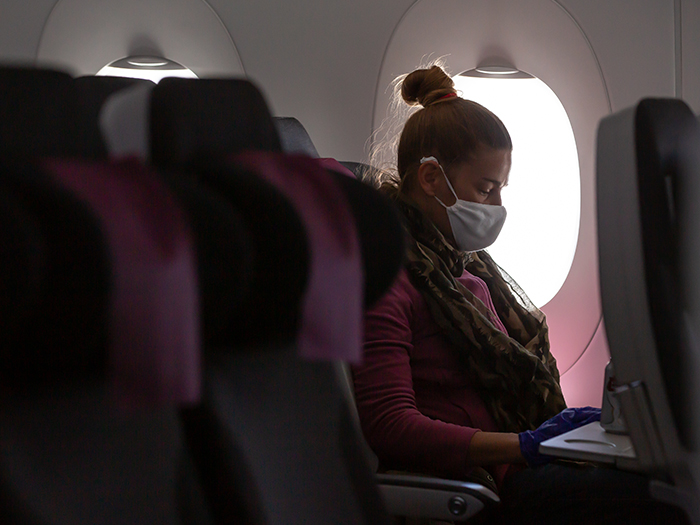4 Critical COVID-19 Risks to the Aviation Sector

COVID-19 devastated revenues and the balance sheets of commercial airlines with quarterly losses for some running from the hundreds of millions into the billions. But from a claims-made perspective, of the sectors affected by the COVID-19 pandemic, aviation is faring pretty well.
The sector has seen few claims directly related to the pandemic and Allianz Global Corporate & Specialty report found that slip and fall accidents, one common source of aviation claims, fell by 94% when compared to April of last year.
“Generally speaking, the risks associated with COVID are not unique to aviation, it just happens to be somewhat of a unique environment when you consider aircraft operations, ” said Brad Meinhardt, managing director of Gallagher’s aerospace practice.
Still, COVID-19 has introduced a variety of new risks that, while not necessarily unique to the sector, are something aviation companies have to grapple with. Here are four that you should be watching.
1) Grounded Aircraft
From people cancelling their vacations to business travelers transitioning their meetings to Zoom, COVID-19 has caused air travel in the U.S. to decline 95% compared to last year, causing many airlines to simply have to park their aircrafts and wait indefinitely — something underwriters were unprepared for when they priced risk.
“One of the risks that airline underwriters hadn’t really contemplated before was the aggregation and accumulation risk of grounded aircraft,” said Garrett Hanrahan, global head of aviation for Marsh JLT Specialty.
Currently, more than 16,000 commercial aircrafts have been grounded worldwide. Grounded planes are subject to a myriad of high-dollar exposures, including damage from Nat CATS like hurricanes, tornadoes or hailstorms.
“The ground exposures seen now are at an unprecedented level, with very substantial numbers of aircraft parked which could lead to unprecedented hull claims which, whilst they don’t escalate, do have a short time lag between incident and payment,” Tracy Toro, managing director of Aon’s Aviation Practice, said.
Outside of the potential for catastrophic claims, grounded aircraft are running up costs in maintenance and storage costs as well.
2) Deep Cleaning and Social Distancing
Outside of grounded aircraft, the airline industry hasn’t experienced many COVID-19 related risks that are unique to their sector. Rather, risks found across sectors, like virus spread, uniquely manifest themselves in the confined space of an airplane cabin.
“You are in a cabin environment where infectious diseases can spread. This is not new to the airline industry, it’s enhanced, but there have always been risks of confined spaces, and it’s not unique to aviation,” Meinhardt said.
Contagion isn’t the only risk airlines face when it comes to deep cleaning and social distancing measures, however.
The UV-light tools sometimes used to clear airplanes during the pandemic, can cause damage to operators if not used properly, and airlines face some reputational risk if passengers determine that they aren’t doing enough for public health.
Delta and American Airlines have already been attacked on Twitter for slacking when it comes to enforcing mask policies and for filling aircraft to capacity, which could lead to reduced profits if passengers abandon them when booking future travel.
3) COVID-19 Workers’ Comp Presumptions
Deep cleaning isn’t just about keeping passengers safe. An airlines employees might be eligible for workers’ compensation if they contract the virus while on the job.
“If you’re an airline you not only have employees that are working in a confined space and are exposed to people coming back on the aircraft and getting off the aircraft in small narrow walkways, you have exposure to the passengers potentially,” Meinhardt said.
Many states are passing presumptions for COVID-19, which may offer protection to airlines workers, further complicating things.
“Initially there was an expectation that clear lines would be drawn between compensability presumptions for essential and non-essential employees. It’s possible state workers’ compensation courts may now adopt a more liberal approach toward compensability for all employees, with some states shifting the burden of proof from the employee to the employer,” Toro said.
Added to the possibility of more employees filing workers’ compensation claims is the risk of catastrophic or long-COVID claims. Workers’ who experience the most catastrophic effects of COVID-19 might experience strokes and organ failure.
Those with long-COVID, may not experience the virus’s most dangerous effects, but they could experience symptoms like exhaustion, muscle aches and other symptoms that could delay their ability to return-to-work.
“The ultimate financial impact of COVID-19, in the workers’ compensation marketplace, likely won’t be known for years,” Toro said.
4) Financial Losses and D&O Exposures
Unlike other lines, like transportation, aviation insurance isn’t experiencing a hard market, but Hanrahan did note that while there is enough capacity to insure the risks aircrafts face, rates are increasing. “We’re not in a hardening market. We’re in a firming market,” he said.
Even so, some lines of insurance that aviation companies need to purchase will be tighter than others.
In particular, the financial losses that airlines are experiencing as a result of COVID-19 could lead to an increase in D&O exposures where events-based litigation and class-action lawsuits have driven up rates in recent years.
“The financial pressures on airlines are impacting some insurance elements more dramatically than others within an airline’s total portfolio. Much has been made of D&O in the current climate,” Toro said.
With coronavirus-related lawsuits coming up against cruise ship lines from their employees, boards of directors at airline companies should expect scrutiny from shareholders on how they’ve handled the COVID-19 pandemic.
If shareholders find any missteps, they might sue board members, especially since many airlines are already facing massive financial losses due to the pandemic leading to D&O losses that wouldn’t have occurred without the virus.
Even if they avoid lawsuits, aviation companies can expect scrutiny on how they handled the pandemic when they go in for D&O renewals.
Silver Linings
Despite the pandemic, the sector still has some areas where they’ve seen growth.
“You can’t necessarily say the industry has been impacted equally across all lines,” Meinhardt said. “Aviation and aerospace is so diverse that you have severe impacts on some business and you have silver linings on others.”
One area is in private charter flights, which has rebounded as stay-at-home orders have lifted. Flights were down 67% in April, but last month Part 135 charters were down just 9%.
“There’s a massive new market to try to attract people that can afford to fly privately that perhaps don’t want to get on an airline because they may feel intimidated by getting in a cabin with a lot of people,” Meinhardt said. “I think it’s got a real heartbeat.”
Additionally, shipping and cargo segments of the sector are poised for growth this year as consumers increasingly order products from online retailers to avoid interacting with other people in a traditional, brick and mortar shop.
“The cargo industry was really buoyed by the growth in e-commerce,” Meinhardt said.
In their 10-Q, Amazon, one of the largest online retailers, reported having more than $27 billion in cash and cash equivalents for the three months ending June 30. Last year, they reported having $23 billion in cash and cash equivalents for the same time period. &










